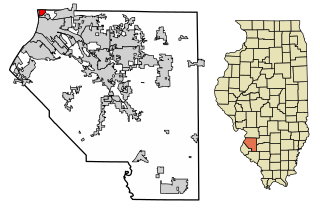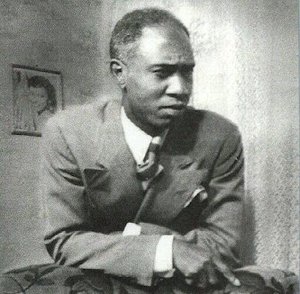Related Research Articles

Brooklyn, is a village in St. Clair County, Illinois, United States. Located two miles north of East St. Louis, Illinois and three miles northeast of downtown St. Louis, Missouri, it is the oldest town incorporated by African Americans in the United States. Its motto is "Founded by Chance, Sustained by Courage." The mayor is Mayor Vera Banks-Glasper.

Melvin Beaunorus Tolson was an American poet, educator, columnist, and politician. As a poet, he was influenced both by Modernism and the language and experiences of African Americans, and he was deeply influenced by his study of the Harlem Renaissance.

The Champaign–Urbana metropolitan area, also known as Champaign–Urbana and Urbana–Champaign as well as Chambana (colloquially), is a metropolitan area in east-central Illinois. As defined by the Office of Management and Budget (OMB), the metropolitan area has a population of 222,538 as of the 2020 U.S. Census, which ranks it as the 207th largest metropolitan statistical area in the U.S. The area is anchored by the principal cities of Champaign and Urbana, and is home to the University of Illinois Urbana-Champaign, the flagship campus of the University of Illinois system.
James Deetz was an American anthropologist, often known as one of the fathers of historical archaeology. His work focused on culture change and the cultural aspects inherent in the historic and archaeological record, and was concerned primarily with the Massachusetts and Virginia colonies. James Deetz was interested in obtaining valuable information that could be used to better understand the lives of early North American colonists, natives, and African Americans. He investigated a variety of material culture related to these groups to better comprehend their social behavior.

For the hydroelectric power plant and HVDC-back-to-back facility in Paraguay, see Acaray Power Plant
Free Frank McWorter was an American born into slavery who bought his own freedom in Kentucky and in 1836 founded the town of New Philadelphia in Illinois; he was the first African American to plat and register a town, and establish a planned community in the United States. The New Philadelphia town site was designated a National Historic Landmark in 2009 and made a National Park Service site in 2022.

The New Philadelphia National Historic Site is the original site of the now-vanished town of New Philadelphia, Illinois, in the United States. It is located near the western Illinois city of Barry, in Pike County.

Flowerdew Hundred Plantation dates to 1618/19 with the patent by Sir George Yeardley, the Governor and Captain General of Virginia, of 1,000 acres (400 ha) on the south side of the James River. Yeardley probably named the plantation after his wife's wealthy father, Anthony Flowerdew, just as he named another plantation "Stanley Hundred" after his wife's wealthy mother, Martha Stanley. A "hundred" was historically a division of a shire or county. With a population of about 30, the plantation was economically successful with thousands of pounds of tobacco produced along with corn, fish and livestock. Sir George paid 120 pounds to build the first windmill in British America.
Moorehead Circle was a triple woodhenge constructed about two millennia ago at the Fort Ancient Earthworks in the U.S. state of Ohio.
Paul A. Shackel is an American anthropologist and a Professor of Anthropology in the Department of Anthropology at the University of Maryland, College Park. He joined the Department of Anthropology in 1996 after working for the National Park Service for seven and a half years. His research interests include Historical Archaeology, Civic Engagement, African Diaspora, Labor Archaeology, and Heritage Studies. He teaches courses in Historical Archaeology, Archaeology of the Chesapeake, and Method and Theory in Archaeology.
John Lambert Cotter was an American archaeologist whose career spanned more than sixty years and included archaeological work with the Works Progress Administration, numerous posts with the National Park Service, and contributions to the development of historical archaeology in the United States.
The archaeology of religion and ritual is a growing field of study within archaeology that applies ideas from religious studies, theory and methods, anthropological theory, and archaeological and historical methods and theories to the study of religion and ritual in past human societies from a material perspective.
The Society for Historical Archaeology (SHA) is a professional organization of scholars concerned with the archaeology of the modern world. Founded in 1967, the SHA promotes scholarly research and the dissemination of knowledge pertaining to historical archaeology. The society is specifically interested in the identification, excavation, interpretation, and conservation of sites and materials on land and underwater. It is the largest such organization in the world and the third largest anthropological organization in the United States.
Edward Baker Jelks was an American archaeologist trained as a prehistorian yet known for his contributions to historical archaeology and leadership roles in multiple anthropological organizations, including the Society for Historical Archaeology and the Society of Professional Archaeologists.

The Kongo cosmogram
Jean Carl Harrington was an American archaeologist best known for his work at Jamestown, Virginia and his contributions to the methodology of historical archaeology. He has been called the "father of historical archaeology in America".
Theresa A. Singleton is an American archaeologist and writer who focuses on the archaeology of African Americans, the African diaspora, and slavery in the United States. She is a leading archaeologist applying comparative approaches to the study of slavery in the Americas. Singleton has been involved in the excavation of slave residences in the southern United States and in the Caribbean. She is a professor of anthropology at Syracuse University, and serves as a curator for the National Museum of Natural History.
Whitney Battle-Baptiste is an American historical archaeologist of African and Cherokee descent. She is an associate professor at the University of Massachusetts Amherst and director of the W.E.B. Du Bois Center at the University. Battle-Baptiste's research focuses on "how the intersection of race, gender, class, and sexuality look through an archaeological lens".
Dr. Faye Venetia Harrison is an American anthropologist. Her research interests include political economy, power, diaspora, human rights, and the intersections of race, gender, and class. She is currently Professor of African American Studies and Anthropology at the University of Illinois at Urbana-Champaign. She formerly served as Joint Professor of Anthropology and African American Studies at the University of Florida. Harrison received her BA in Anthropology in 1974 from Brown University, and her MA and PhD in Anthropology from Stanford University in 1977 and 1982, respectively. She has conducted research in the US, UK, and Jamaica. Her scholarly interests have also taken her to Cuba, South Africa, and Japan.
References
- 1 2 3 Jill Dennis, "Buried Treasure: UI dig uncovers Illinois town that welcomed blacks and whites", Illinois, Vol. 21 (2), September/October 2008, accessed 1 June 2009
- ↑ James Janega, "Long-buried story of black America: Archeologists provide concrete details about African-American land speculators and utopian pioneers in the Midwest", Chicago Tribune.com, 8 June 2008, accessed 1 June 2009
- ↑ Juliet E.K. Walker, “New Philadelphia” Archived 2008-05-09 at the Wayback Machine , Center for Heritage Resource Studies, University of Maryland, 2006, accessed 1 June 2009
- ↑ John L. Cotter Award in Historical Archaeology, 2009 - Christopher C. Fennell Archived 2009-05-31 at the Wayback Machine , Society for Historical Archaeology, accessed 1 June 2009
- ↑ Christopher C. Fennell, Crossroads and Cosmologies: Diasporas and Ethnogenesis in the New World, University Press of Florida